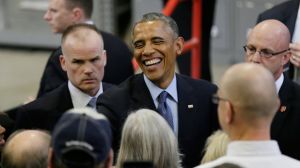
President Barack Obama greets audience members after speaking at Cedar Falls Utilities, Wednesday, Jan. 14, 2015, in Cedar Falls, Iowa. (AP Photo/Charlie Neibergall)
When FDR came into office 90 percent of farmers didn’t have electricity, even though kids in New York City were playing with electric toys. The private electrical utilities had the market sewn up and they had no particular reason to expand service or charge reasonable prices. Remember that great photograph of FDR with his cigarette tipped upwards in a long holder? He took on those special interests, and that same confidence came shining through President Obama today.
Although the president’s party lost the midterms, the president himself has found his voice. We now understand that demand for high-capacity Internet access is outpacing supply; we get that high prices for this unregulated utility are a key barrier to adoption and that leaving out a quarter of Americans threatens our ability to survive on the global stage. (We’re talking about the global stage without embarrassment — that’s new.) We have a story about why regulation is needed: unleashing the regulatory ideal means creating opportunity for everyone.
Most importantly, we have a story about us, about Americans, and why getting this high speed Internet access issue right presents at once one of the key social justice challenges of our time and the greatest opportunity for America in a century.
Across America, many mayors are calling for the creation of fiber-optic networks serving municipal buildings as well as other city locations where people live, work and play. America’s basic two-way communications lines haven’t been upgraded since the introduction of the cable modem more than 15 years ago, and mayors are listening to citizens and businesses clamoring for world-class, inexpensive, symmetric and ubiquitous Internet access over fiber. Indeed, the availability of inexpensive fiber-optic access in cities is rapidly becoming as important a social issue as electrification was decades ago; like electricity, cheap and unlimited Internet access is an essential input into every aspect of future economic, cultural and social life. But as a nation, we are sinking in the ranks of developed nations when it comes to the percentage of fiber connections in our overall high-speed Internet access connections.
The FCC has suggested that 25Mbps is a good potential threshold for high speed Internet access in America, but 90 percent of 25Mbps subscriptions in the US go to local cable monopolies that can charge whatever they want. DSL just can’t compete for these higher speeds: Where local cable monopolies face competition only from copper, they get 98-99 percent of subscriptions for 25Mbps. This landscape is radically transformed by the presence of a fiber competitor. Where fiber-to-the-home (FTTH) exists, cable gets just 56 percent of subscriptions for 25 Mbps. But there is very little FTTH in the US: FTTH makes up just 9.5 percent of overall US subscriptions.
More broadly, the overall Internet connectivity picture for many urban residents in the US is grim, even for speeds far slower than those that fiber allows. Indeed, the digital divide in US cities remains extraordinary, amplifying and entrenching existing inequalities.
As urban and rural communities across the US experience the drawbacks of insufficient bandwidth, local communities have mobilized to address the issue themselves by building municipal fiber networks. But approximately 19 states have established legal prohibitions on municipal fiber provision. Industry lobbyists and ideologically driven national groups like the American Legislative Exchange Council (ALEC) have pushed these laws at the state level with the aim of protecting entrenched incumbents by frustrating the efforts of municipalities to develop their own advanced communications networks.
By proposing to block those state laws, get rid of idiotic EPA and DOT and other federal regulations that get in the way of fiber projects, and push out great information from the Department of Commerce to communities hoping to build fiber, the president is appealing to our sense of collective identity. The real story behind President Obama’s remarks today is not just about economic development. It’s a story of creating anew a genuine middle class that has opportunity and choices and optimism. This is a story of us.
It was quite a day.



